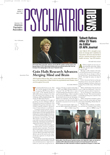In the 1940s, a child in Alabama was terrified that she would be damned for“ unclean thoughts.” If that child were alive today, she would have it much better—she would not only receive medication for her obsessive-compulsive disorder (OCD), but psychiatrists would have a pretty good idea of how medications counter the disorder in her brain.
Specifically, the major center in the brain that manufactures fear is the amygdala. Compared with healthy children, children with OCD have an abnormally larger left amygdala volume, according to a study by David Rosenberg, M.D., chief of child psychiatry and psychology at Wayne State University, and colleagues and published in the February Neuropsychopharmacology. Also, when a selective serotonin reuptake inhibitor (SSRI) is used to treat children with OCD, their abnormally large left amygdala volume shrinks, the study also revealed.
The amygdala is believed to be key in the pathophysiology of OCD because of its prominent role in fear processing and because it is a crucial target for serotonin reuptake inhibitors, the medications of choice for treating OCD.
So in their study, Rosenberg and his coworkers used magnetic resonance imaging to measure the size of the amygdala in 11 children with OCD and 11 healthy comparison subjects.
They found that the left amygdala and the right amygdala volumes were about the same size in the healthy children, but that the left amygdala was proportionally bigger in the children with OCD.
The researchers then treated the children with OCD with the SSRI paroxetine for 16 weeks, at which time they used magnetic resonance to measure their amygdalae.
They found that the children's left amygdala volume had shrunk significantly after treatment. In contrast, no significant changes in either left or right amygdala volume were evident among the healthy children from the start of the study to followup at 16 weeks.
“These preliminary findings,” the investigators concluded in their study report, “suggest that abnormal asymmetry of the amygdala may play a role in the pathogenesis of obsessive-compulsive disorder, and that paroxetine treatment may be associated with a reduction in amygdala volume.”
An abstract of the study, “Amygdala Volume Reductions in Pediatric Patients With Obsessive-Compulsive Disorder Treated With Paroxetine: Preliminary Findings,” is posted online at<www.nature.com/cgi-taf/DynaPage.taf?file=/npp/journal/v29/n4/abs/1300399a.html>.▪
